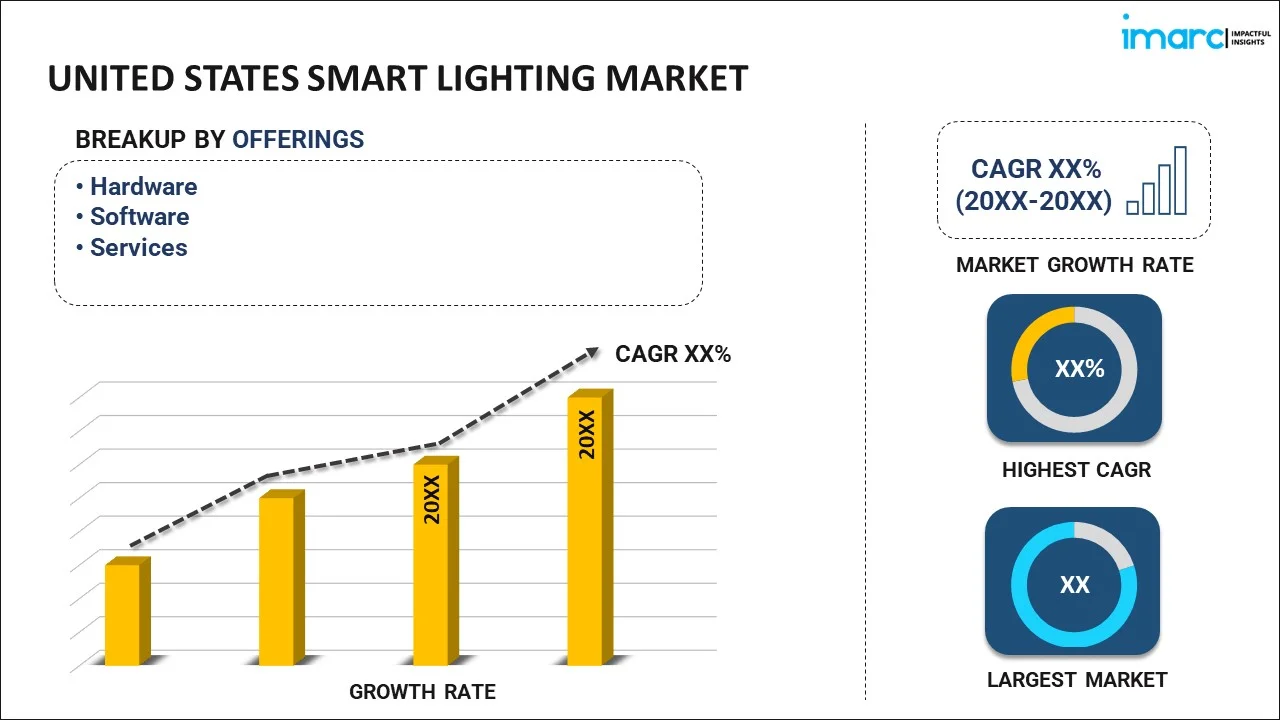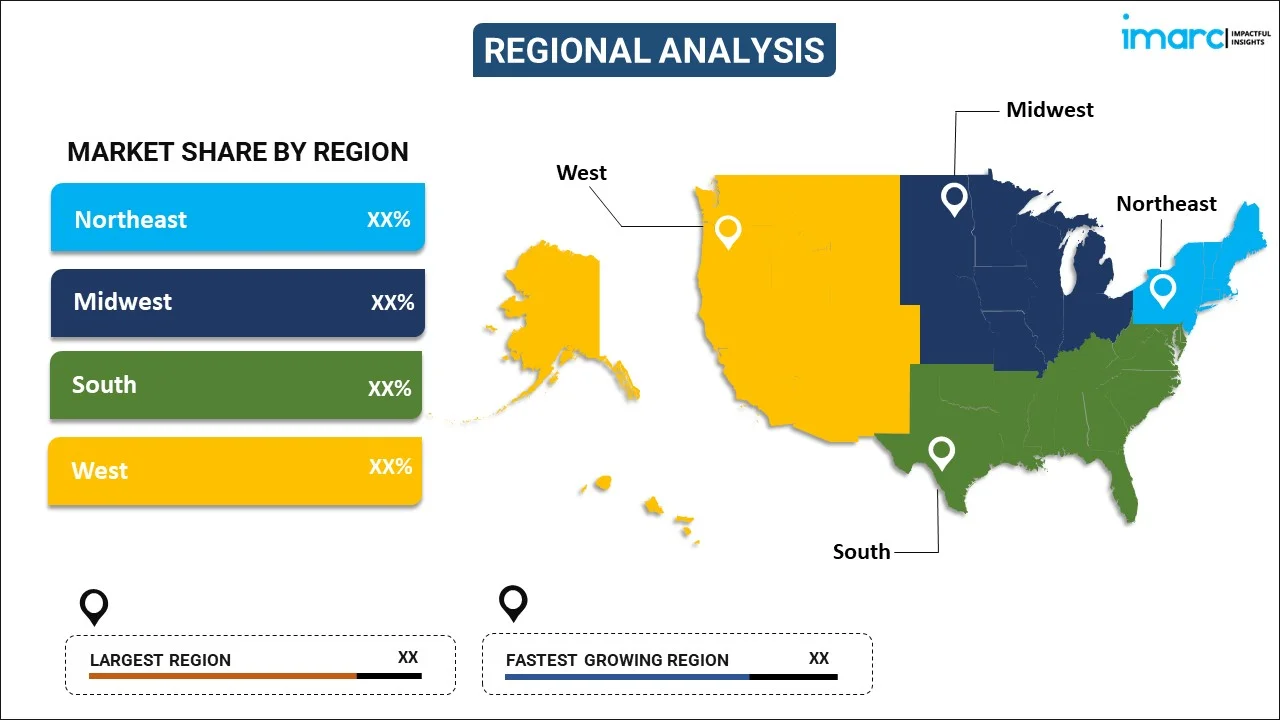
United States Smart Lighting Market Report by Offering (Hardware, Software, Services), Communication Technology (Wired Technology, Wireless Technology ), Installation Type (New Installation, Retrofit Installation), Light Source (LED Lamps, Fluorescent Lamps, Compact Fluorescent Lamps, High Intensity Discharge Lamps, and Others), Application (Commercial, Residential, Public Infrastructure, and Others), and Region 2025-2033
Market Overview:
United States smart lighting market size reached USD 4,714.1 Million in 2024. Looking forward, IMARC Group expects the market to reach USD 16,158.7 Million by 2033, exhibiting a growth rate (CAGR) of 14.67% during 2025-2033. The growing advancements in wireless communication technologies, such as Bluetooth and Wi-Fi, rising interest in human-centric lighting that can adjust to individual needs and circadian rhythms and increasing emergence of lighting as a service (LaaS) represent some of the key factors driving the market.
|
Report Attribute
|
Key Statistics
|
|---|---|
|
Base Year
|
2024 |
|
Forecast Years
|
2025-2033
|
|
Historical Years
|
2019-2024
|
| Market Size in 2024 | USD 4,714.1 Million |
| Market Forecast in 2033 | USD 16,158.7 Million |
| Market Growth Rate (2025-2033) | 14.67% |
Smart lighting involves the use of intelligent technology to control lighting systems. It integrates various components like sensors, controllers, and connectivity technology like wireless fidelity (Wi-Fi) or Bluetooth to manage and adjust lighting based on environmental conditions and user preferences. It is available in ambient lighting systems, task lighting, and accent lighting, each tailored for specific environments. It offers substantial benefits, such as personalized lighting environments, improved security through motion-detection capabilities, and reduced operational costs due to lower energy usage and maintenance needs. It is utilized in diverse sectors, including residential, commercial, and public infrastructure.
United States Smart Lighting Market Trends:
At present, rising advancements in wireless communication technologies, such as Bluetooth and Wi-Fi, for facilitating the seamless operation of smart lighting systems represent one of the major factors impelling the market growth in the United States. These technologies enable easy installation and interoperability of smart lighting products with other smart devices, enhancing user experience and system functionality. Additionally, the increasing integration of smart lighting systems with the internet of things (IoT) for more sophisticated and energy-efficient lighting solutions that can be controlled remotely and customized to individual preferences is contributing to the growth of the market in the country. Besides this, the growing awareness about environmental sustainability and the need for energy conservation among people and businesses are turning to smart lighting solutions to reduce energy consumption and carbon footprint. The adoption of light-emitting diode (LED) bulbs, known for their low energy usage and long lifespan, is particularly noteworthy in this context. Moreover, the rising number of initiatives and regulations aimed at phasing out incandescent bulbs and promoting energy-efficient lighting solutions is prompting the adoption of smart lighting technologies. The government-led smart city projects are incorporating smart lighting solutions to improve public safety and reduce energy costs. In addition, there is an increase in the demand for customization and personalization in lighting systems as users are seeking solutions that allow them to adjust lighting colors, intensity, and patterns to suit different moods or occasions. This demand is driving innovation in smart lighting, leading to products that offer a higher degree of personalization, further enhancing user experience and satisfaction. Furthermore, the growing interest in human-centric lighting that can adjust to individual needs and circadian rhythms to improve health and well-being is positively influencing the market growth in the country. This aspect of smart lighting is gaining traction, particularly in healthcare and workplace settings, where lighting can significantly impact productivity and well-being. Apart from this, the rising emergence of lighting as a service (LaaS) is allowing buyers to lease lighting infrastructure instead of purchasing it outright, reducing upfront costs and shifting the responsibility for maintenance and upgrades to the service provider.
United States Smart Lighting Market Segmentation:
IMARC Group provides an analysis of the key trends in each segment of the market, along with forecasts at the country level for 2025-2033. Our report has categorized the market based on offering, communication technology, installation type, light source, and application.
Offering Insights:

- Hardware
- Lights and Luminaires
- Lighting Controls
- Software
- Services
- Design and Engineering
- Installation
- Post-Installation
The report has provided a detailed breakup and analysis of the market based on the offering. This includes hardware (lights and luminaires and lighting controls), software, and services (design and engineering, installation, and post-installation).
Communication Technology Insights:
- Wired Technology
- Wireless Technology
A detailed breakup and analysis of the market based on the communication technology have also been provided in the report. This includes wired technology and wireless technology.
Installation Type Insights:
- New Installation
- Retrofit Installation
The report has provided a detailed breakup and analysis of the market based on the installation type. This includes new installation and retrofit installation.
Light Source Insights:
- LED Lamps
- Fluorescent Lamps
- Compact Fluorescent Lamps
- High Intensity Discharge Lamps
- Others
A detailed breakup and analysis of the market based on the light source have also been provided in the report. This includes LED lamps, fluorescent lamps, compact fluorescent lamps, high intensity discharge lamps, and others.
Application Insights:
- Commercial
- Residential
- Public Infrastructure
- Others
The report has provided a detailed breakup and analysis of the market based on application. This includes insurance commercial, residential, public infrastructure, and others.
Regional Insights:

- Northeast
- Midwest
- South
- West
The report has also provided a comprehensive analysis of all the major regional markets, which include Northeast, Midwest, South, and West.
Competitive Landscape:
The market research report has also provided a comprehensive analysis of the competitive landscape. Competitive analysis such as market structure, key player positioning, top winning strategies, competitive dashboard, and company evaluation quadrant has been covered in the report. Also, detailed profiles of all major companies have been provided.
United States Smart Lighting Market Report Coverage:
| Report Features | Details |
|---|---|
| Base Year of the Analysis | 2024 |
| Historical Period | 2019-2024 |
| Forecast Period | 2025-2033 |
| Units | Million USD |
| Scope of the Report | Exploration of Historical Trends and Market Outlook, Industry Catalysts and Challenges, Segment-Wise Historical and Future Market Assessment:
|
| Offerings Covered |
|
| Communication Technologies Covered | Wired Technology, Wireless Technology |
| Installation Types Covered | New Installation, Retrofit Installation |
| Light Sources Covered | LED Lamps, Fluorescent Lamps, Compact Fluorescent Lamps, High Intensity Discharge Lamps, Others |
| Applications Covered | Commercial, Residential, Public Infrastructure, Others |
| Regions Covered | Northeast, Midwest, South, West |
| Customization Scope | 10% Free Customization |
| Post-Sale Analyst Support | 10-12 Weeks |
| Delivery Format | PDF and Excel through Email (We can also provide the editable version of the report in PPT/Word format on special request) |
Key Questions Answered in This Report:
- How has the United States smart lighting market performed so far and how will it perform in the coming years?
- What has been the impact of COVID-19 on the United States smart lighting market?
- What is the breakup of the United States smart lighting market on the basis of offering?
- What is the breakup of the United States smart lighting market on the basis of communication technology?
- What is the breakup of the United States smart lighting market on the basis of installation type?
- What is the breakup of the United States smart lighting market on the basis of light source?
- What is the breakup of the United States smart lighting market on the basis of application?
- What are the various stages in the value chain of the United States smart lighting market?
- What are the key driving factors and challenges in the United States smart lighting?
- What is the structure of the United States smart lighting market and who are the key players?
- What is the degree of competition in the United States smart lighting market?
Key Benefits for Stakeholders:
- IMARC’s industry report offers a comprehensive quantitative analysis of various market segments, historical and current market trends, market forecasts, and dynamics of the United States smart lighting market from 2019-2033.
- The research report provides the latest information on the market drivers, challenges, and opportunities in the United States smart lighting market.
- Porter's five forces analysis assist stakeholders in assessing the impact of new entrants, competitive rivalry, supplier power, buyer power, and the threat of substitution. It helps stakeholders to analyze the level of competition within the United States smart lighting industry and its attractiveness.
- Competitive landscape allows stakeholders to understand their competitive environment and provides an insight into the current positions of key players in the market.
Need more help?
- Speak to our experienced analysts for insights on the current market scenarios.
- Include additional segments and countries to customize the report as per your requirement.
- Gain an unparalleled competitive advantage in your domain by understanding how to utilize the report and positively impacting your operations and revenue.
- For further assistance, please connect with our analysts.
 Request Customization
Request Customization
 Speak to an Analyst
Speak to an Analyst
 Request Brochure
Request Brochure
 Inquire Before Buying
Inquire Before Buying




.webp)




.webp)












